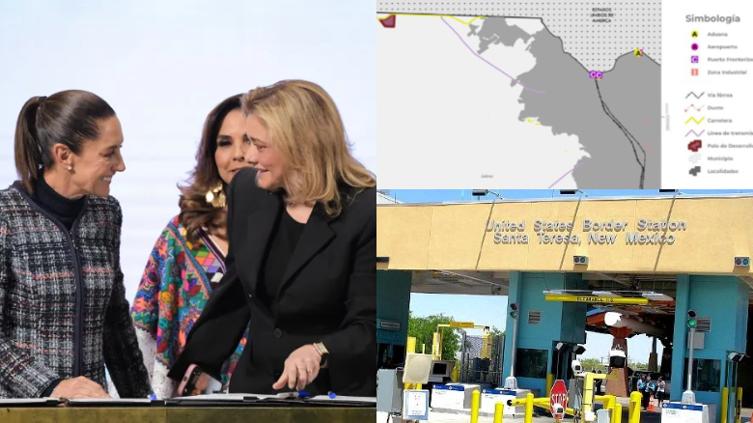The document is issued by the federal Ministry of Economy led by Marcelo Ebrard and officially recognizes the Development Economic Pole for Well-being San Jerónimo (Podecobi San Jerónimo).
On June 26, President of Mexico Claudia Sheinbaum and Governor of Chihuahua Maru Campos signed an agreement to collaborate on the Pole. This is the declaration, and it remains for the Federal Government to publish the agreement between the federal and state authorities.
It covers the locality of Jerónimo in the municipality of Juárez, covering an area of 60.3 hectares.
Map of the Pole.
Strategic location:
It is located on the border, facing Santa Teresa (New Mexico).
Near the industrial corridor, rail and road access, and the Ciudad Juárez airport.
It offers a logistical alternative to the congested El Paso (Texas) crossing, where transport blockades due to measures against illegal migration and smuggling are frequent.
Priority productive vocations:
Logistics
Industrial innovation
Automotive and electromobility
Medical devices
Technological services
Social and educational benefits:
It does not affect indigenous communities or agrarian nuclei.
High potential population: more than 1.5 million inhabitants in the metropolitan area.
Extensive offer of upper secondary and higher education institutions in Juárez and neighboring municipalities.
Infrastructure and industrial feasibility:
Industrial land use already authorized.
Availability of basic services such as gas and electricity.
Close to existing industrial parks (Juárez accounts for 60% of the industrial parks in Chihuahua).
Sustainability and environment:
Environmentally viable area, not located in protected natural areas.
Outstanding ecological connectivity.
Ownership and administration:
The land is publicly owned by the state.
The state and the Ministry of Economy will coordinate the formalization of tax incentives.
Objectives:
Promote regional and national economic development.
Attract private investment in strategic sectors.
Integrate Mexico into global value chains.
Promote employment and social well-being.
What benefits will the San Jerónimo Well-being Economic Development Pole have?
Tax incentives:
Immediate deduction of 100% on new fixed asset investments (machinery and equipment).
Additional deduction of 25% on training programs.
Additional deduction of 25% on research and development (R&D) initiatives.
Support for investment:
Promotion of productive investment for Mexican and foreign companies.
Relocation of foreign companies to the poles.
Promotion of investments in machinery, equipment, and technology.
Promotion of training:
Support for dual training programs (education and work practice).
Promotion of innovation:
Support for technological innovation projects and development of new processes or products.
Strengthening of productive chains:
Promotes the strengthening of national value chains.
Encourages the inclusion of micro, small, and medium enterprises (MSMEs).
Economic and social impact:
Increase in job creation.
Improvement in infrastructure and regional development.
Contribution to import substitution.
Validity.
— News Original —
Oficial: Declaran San Jerónimo Polo Económico para el Bienestar (MAPA)
El documento es emitido desde la Secretaría de Economía federal que encabeza Marcelo Ebrard y oficializa el denominado Polo de Desarrollo Económico para el Bienestar San Jerónimo (Podecobi San Jerónimo). n nEl pasado 26 de junio firmaron la presidenta de México, Claudia Sheinbaum; y la gobernadora de Chihuahua, Maru Campos, el convenio para colaborar en el Polo. Esta es la declaratoria y falta que el Gobierno Federal publique el acuerdo de las mandatarias federal y estatal. n nConsta de la localidad de Jerónimo en el municipio de Juárez, con superficie de 60.3 hectáreas. n nMapa del Polo. n nDestaca la Declaratoria. n nUbicación estratégica: n nEstá en la frontera, frente a Santa Teresa (Nuevo México). n nCerca del corredor industrial, acceso ferroviario, carretero y al aeropuerto de Ciudad Juárez. n nAporta una alternativa logística al congestionado cruce de El Paso (Texas) donde también son constantes los bloqueos de transporte por medidas contra migración ilegal y contrabando. n nVocaciones productivas prioritarias. n nLogística n nInnovación industrial n nAutomotriz y electromovilidad n nDispositivos médicos n nServicios tecnológicos n nBeneficio social y educativo. n nNo afecta comunidades indígenas ni núcleos agrarios. n nAlta población potencial: más de 1.5 millones de habitantes en la zona metropolitana. n nAmplia oferta de instituciones educativas de nivel medio superior y superior en Juárez y municipios aledaños. n nInfraestructura y factibilidad industrial. n nUso de suelo industrial ya autorizado. n nDisponibilidad de servicios básicos como gas y electricidad. n nCercano a parques industriales existentes (Juárez concentra el 60% de los parques industriales de Chihuahua). n nSostenibilidad y medio ambiente. n nZona viable ambientalmente, sin ubicarse en áreas naturales protegidas. n nConectividad ecológica destacada. n nPropiedad y administración. n nLos predios son de propiedad pública estatal. n nEstado y Secretaría de Economía coordinarán la formalización de estímulos fiscales. n nObjetivos. n nFomentar el desarrollo económico regional y nacional. n nAtraer inversión privada en sectores estratégicos. n nIntegrar a México en cadenas globales de valor. n nPromover el empleo y el bienestar social. n n¿Qué beneficios tendrá el Polo del Desarrollo Económico para el Bienestar San Jerónimo? n nEstímulos fiscales. n nDeducción inmediata del 100% en inversión de activos fijos nuevos (maquinaria y equipo). n nDeducción adicional del 25% en programas de capacitación. n nDeducción adicional del 25% en iniciativas de investigación y desarrollo (I+D). n nApoyo a la inversión. n nFomento a la inversión productiva para empresas mexicanas y extranjeras. n nRelocalización de empresas extranjeras en los polos. n nPromoción de inversiones en maquinaria, equipo y tecnología. n nImpulso a la capacitación. n nApoyo a programas de capacitación dual (educación y práctica laboral). n nFomento a la innovación. n nImpulso a proyectos de innovación tecnológica y desarrollo de nuevos procesos o productos. n nFortalecimiento de cadenas productivas. n nPromueve el fortalecimiento de cadenas de valor nacionales. n nFomenta la inclusión de micro, pequeñas y medianas empresas (MIPYMES). n nImpacto económico y social. n nIncremento en la generación de empleos. n nMejora en infraestructura y desarrollo regional. n nContribución a la sustitución de importaciones. n nVigencia.
